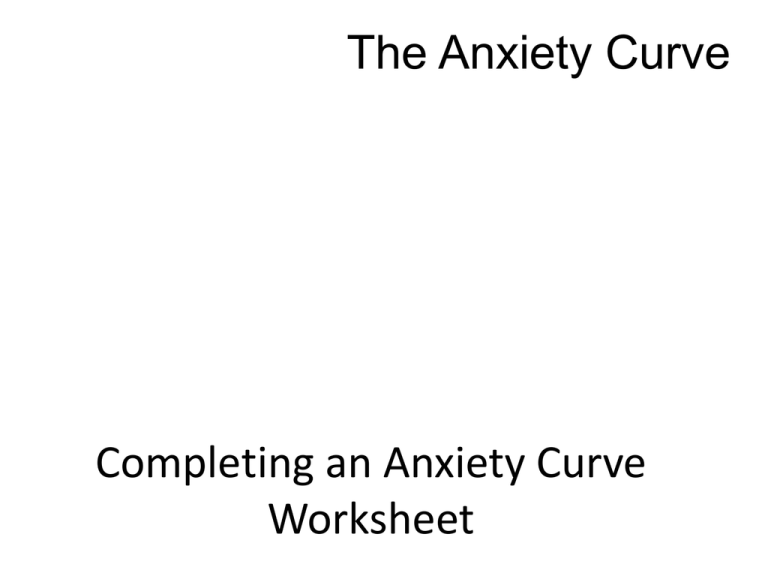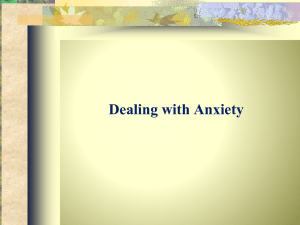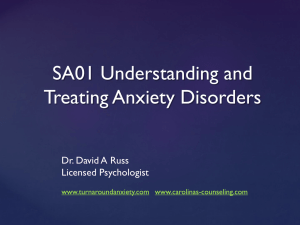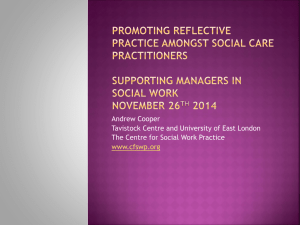Completing an Anxiety Curve - The Incredible 5 Point Scale
advertisement

The Anxiety Curve Completing an Anxiety Curve Worksheet Why is it so important to recognize stress, anxiety and panic? • Possibly the #1 problem related to a loss of control. • Past assumptions about behavior need to be seriously questioned given what we now know about the brain. Punishment • • • • • • Any stimulus that represses a behavior Weakening behavior by adding a negative stimulus Does not teach self-management or independence Suspension from school is by definition, punishment. Suspension is not supported in the educational research Punishment is not supported in educational research Compromise • One of the most important skills we can teach to an explosive student. • Compromise replaces compliance as a goal. • Create opportunities to teach compromise is low emotional moments. • This takes lots of practice. Compromise: I’m a little bit happy and you are a little bit happy but neither one of us is all the way happy. Ross Greene’s Plan C • These are all the things that may become priorities someday but are not today. • This plan is full of many behaviors you’re going to just let go for now. • This plan helps us meet the goal of decreasing the number of meltdowns and keeping the general peace. • Try not to even mention these behaviors When you attend to the anxiety curve, you are proactively deciding when and over what issues your student will possibly have a meltdown. In doing so you are exerting more control…not less. Define your levels • 5 = Out of control. Never worth it. Physical and emotional event for everyone. Might be dangerous. Might have to intervene to maintain safety. This is not a time to teach. Take the path of least physical intervention. Your focus should be on not ever getting here again. Revisit your proactive plan. Warning! • Don’t try to solve problems during an emergency. • Remember about 911. Level 4 • 4 = This is a very delicate level – situation could go either way. Sometimes can be remedied by being quiet. This is often too late for “redirection”. Your energy should be spent calming the situation. Not the time to draw lines in the sand. Adults tend to become inflexible at this point and that pushes things up to 5. Attend to your own body and breathing. Back as far off as possible. Level 3 • 3 = This is when your attention should be on refocusing the person in a very relaxing way. This is your last hope prior to the near explosive 4. Have a plan for this point – you might be starting to panic yourself. You might be able to move yourself and coax the person to a quiet place. This is not a good time to teach, you should have a relationship with the person and use your best “supportive language” to get through the moment. Level 2 • 2 = your first red flag. Subtle signs of stress. This is your best chance at redirection or focus on proactive strategies such as calming activities, more visual support, a quiet place to work, and reframing the demand. This is the level most often missed by teachers and caregivers. This is the best time to prompt the use of self-management. The person and you are both still fairly calm. Good choices can be made at this level. Level 1 • 1 = This is when you teach. This is when you carry out your IEP teaching goals. Teach social skills. Teach the use of the 5 point scale. Teach using power cards and social stories. Teach relaxation and calming sequences. Share the emergency plans with the person – create visual prompts to notify person that emergency plan should start. This might be a stop sign or a small scale. • Over practice predictable routines. A Goal: To think clearly in the midst of frustration The Anxiety Curve A Visual Representation of Anxiety That Helps All of Us Know What to Do The Anxiety Curve Teaching and Practicing happens at 1 or 2. Redirection at 3. Protection, silence and nerves of steel at 4 & 5. Be the person’s advocate / ally 1 - 5 - 1 3 2 1 4 5 4 3 2 1 One example of getting student input What does the best day look like? What does the worst day look like? Who? What? Where? When? Identify Coping Strategies • Don’t forget to look to ‘misbehavior’ as a starting point to figure out coping and calming strategies • Who, what, where, when, Why • (reading Moby Dick example) Complete two - 5 Point scale worksheets to accompany the anxiety curve. 1. Escalation 1 - 5 2. De-escalation 5 - 1 ‘5’ and ‘1’ might look the same, but ‘2’ , ‘3’, and ‘4’ for the student and for our support, will look different. Handouts Anxiety Curve Worksheet visual cheat sheet for students, staff, family When Things Fall Apart • • • • Remain calm Protect others and self SILENCE The concept of Refocus and Re-engage vs. Redirection • Rethink the student’s support plan to increase chances for a successful day











